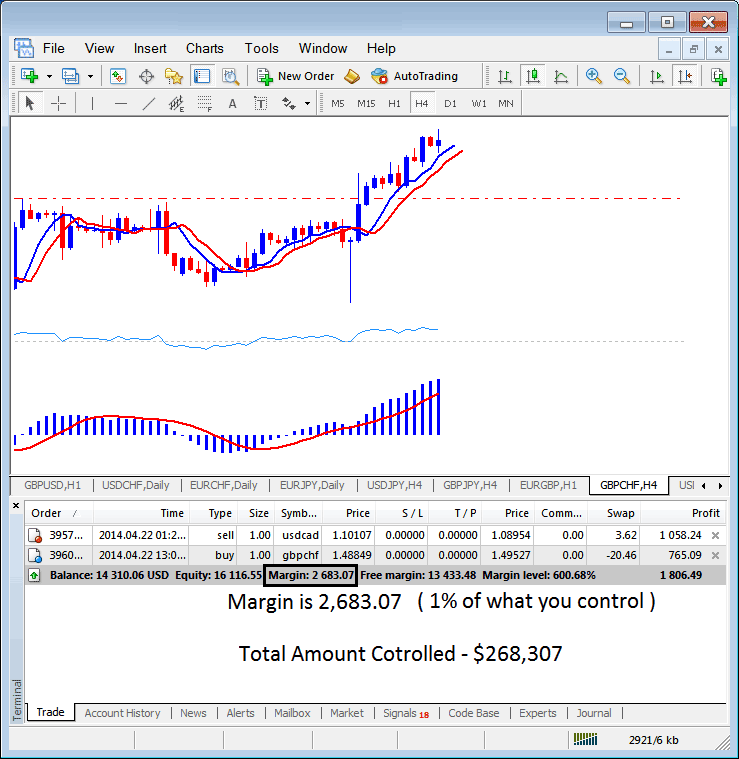Explain What's Leverage? Explain What is Stock Margin?
The definition of Leverage is having the ability to control a big amount of money using very little of your own money & borrowing the rest - this is what makes the stock trading market to attract many investors.
We shall explain leverage first and then explain margin in this learn how to calculate stock leverage and margin guide.
Example:
We shall us this example to explain what leverage is? If your broker gives you leverage of 100:1 (this is best option to select as the maximum leverage for any account)
This means you borrow $100 dollars for every dollar you have in your trading account.
To put in another way your broker gives you $100 dollars for every one dollar in your account. This is what is known as leverage.
This means if you open an account with $1,000 and your leverage is 100:1, then you get $100 for every $1 you that you have in your account, the total amount which you will control is:
If for 1 dollar the broker gives you 100
Then if you have 1,000 you will get a total of:
$1,000 * 100 = $100,000
Now you control 100,000 dollars of Investment
Most new traders ask what leverage is best leverage for $1,000, or $2,000, or $5,000 dollars account? - The best leverage option to choose when opening a live account is always 100:1 & not 400:1.
What's Stock Margin?
Stock Margin is the amount of money required by your broker so that to allow you to continue trading with borrowed amount.
In other words the question what's margin in Indices Trading? can be described as the money required to cover open stock trades & is expressed in percent. For 100:1, the amount you will control is 100,000 dollars as described in the above examples.
Now can you compare a investor investing $1,000 with another one that's investing $100,000? Obviously Not. This is how it works: it takes you from that retail investor investing $1,000 to that investing $100,000. Where does this extra cash come from? - You borrow it from your broker in what's simply referred to as Leverage. This money that you borrow, you borrow it against the $1,000 dollar of your own money which you deposit with your broker. If you were to explain what this leverage means - then it's the ability to control a big amount of money using very little of your own money & borrowing the rest. Otherwise, if you were trade without this leverage it would not be as profitable as it is, in fact you can still select not to use leverage, using the 1:1 leverage option but you would not make money and it would take too long to make any profit.
Example of how to calculate leverage & margin:
Indices Margin required in this case is $1,000 dollars (your money) if it's expressed as a percent of $100,000 dollars in your account which you control it is:
If leverage = 100:1
1,000 / 100,000 * 100= 1 %
Margin required = 1 %
(1/100 *100= 1%)
'Trade Forex Trading - Please simplify because I am Beginner Trader'
(Simplify - your capital is $1,000 after leverage you control $100,000 - $1,000 is what percent of $100,000 - it's 1 percent) that is your margin requirement for your account.
The margin example explained and illustrated below, the set leverage ratio option is 100:1, margin which is 1 % is $2683.07, therefore the total sum controlled by trader is: $268,307 - this is because with this leverage the trader has used little of his money and borrowed the rest of the amount, with this set at 100:1, trader is using 1% of their capital, this 1 % equals to $2683.07, if 1% equals to $2683.07 then 100% is $268,307

Trading Leverage & Margin Discussed
- If = 50:1 Leverage
Then margin requirement = 1/50 *100= 2%
If you have $1,000,
1,000* 50 = $50,000.
1,000 / 50,000 * 100= 2 percent
(Simplify - your capital is $1,000 after leverage you now control $50,000 - $1,000 is what percentage of $50,000 - it's 2 %) that's your margin requirement
- If = 20:1 Leverage
Then the requirement = 1/20 *100= 5%
If you have $1,000,
1,000* 20 = $20,000.
1,000 / 20,000 * 100= 5 %
(Simplify - your capital is $1,000 after leverage you now control $20,000 - $1,000 is what percent of $20,000 - it's 5 %) that is your margin requirement
- If = 10:1 Leverage
Then the requirement is = 1/10 *100= 10%
If you have $1,000,
1,000* 10 = $10,000.
1,000 / 10,000 * 100= 10 %
(Simplify - your capital is $1,000 after leverage you now control $10,000 - $1,000 is what percent of $10,000 - it's 10 %) that's your margin requirement
What is Difference Between Maximum Leverage & Used Leverage?
However, you should note that there's a difference between maximum leverage ( leverage given by your broker which is the highest indices leverage you can trade with if you select to) and used leverage ( leverage depending on the lots you have opened/open trades). One is the broker's (Maximum Leverage) and the other is trader's (Used Leverage). To explain this leverage concept we shall use the stock trading example above:
If your broker has given you 100:1 Max Leverage, but you only open a trade of $10,000 dollars then Used Leverage is:
$10,000: $1,000 dollars (your money)
10:1
Your have used 10:1 Leverage, but your max is still 100:1 Leverage. This means that even if you are given 100:1 Maximum Leverage or 400:1 Max Leverage, you do not have to use all of it. It is best to keep your used leverage to a maximum of 10:1 but you will still select 100:1 maximum leverage option for your trading account. The extra leverage will give you what we call Free Margin, As long as you have some Free margin on your account then your trades will not get closed by your broker because this margin requirement will remain above the required level.
When it comes to trading indices one of your rules: money management rules on your trading plan should be to use leverage below 5:1.
In the above image examples, the trader is using $2683.07, total controlled amount is $268,307, but trading account equity is $16,116.55, therefore used leverage is ( $268,307 divide by 16,116.55 ) = 16.64 : 1
16.64 : 1 Used Leverage
Indices Margin accounts allows traders to control a large amount of currency using little of their own while borrowing the rest
Obtaining this account will enable you to borrow money from the broker to trade lots with.
The amount of borrowing power your account gives you what is called 'leverage', and is usually expressed as a ratio - a ratio of 100:1 leverage means you can control resources worth 100 times your deposit amount.
What this means in Indices terms is that with 1% margin in your account you can control a trade worth $100,000 with a $1,000 deposit.
However, Trading this trading account increases both potential for profits as well as losses. In you can never lose more than you invest, losses are limited to your deposits & usually brokers will close a trade transaction which extends beyond your deposit amount by executing a margin call. Traders must therefore try to keep their margin level above that required. By using money management rules & keeping your used leverage below 5:1.


